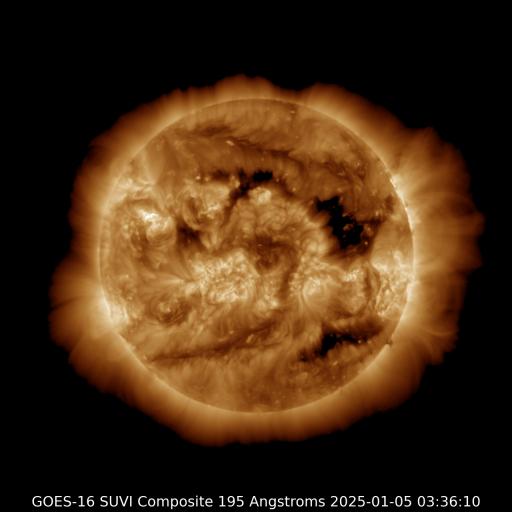Viewing archive of Monday, 3 January 2011
Solar activity report
Any mentioned solar flare in this report has a scaling factor applied by the Space Weather Prediction Center (SWPC). Because of the SWPC scaling factor, solar flares are reported as 42% smaller than for the science quality data. The scaling factor has been removed from our archived solar flare data to reflect the true physical units.
Report of Solar-Geophysical Activity 2011 Jan 03 2200 UTCPrepared by the NOAA © SWPC and processed by SpaceWeatherLive.com
Joint USAF/NOAA Report of Solar and Geophysical Activity
SDF Number 003 Issued at 2200Z on 03 Jan 2011IA. Analysis of Solar Active Regions and Activity from 02-2100Z to 03-2100Z
Solar activity remained at very low levels. Region 1141
(N35W50) produced isolated low-level B-class flares. No significant
changes were observed in Region 1141. It remained a Bxo group with a
beta magnetic configuration. Region 1142 (S13E07) showed an increase
in intermediate spots and was classified as a Dsi group with a beta
magnetic configuration. No new regions were numbered.
IB. Solar Activity Forecast
Solar activity is expected to be very
low to low during the period (04 - 06 January) with a chance for an
isolated C-class flare.
IIA. Geophysical Activity Summary 02-2100Z to 03-2100Z
The geomagnetic field was quiet.
IIB. Geophysical Activity Forecast
Geomagnetic field activity is
expected to be at quiet levels during days 1 - 2 (04 - 05 January).
Activity is expected to increase to quiet to unsettled levels on day
3 (06 January) as a recurrent coronal hole high-speed stream begins
to disturb the field.
III. Event Probabilities 04 Jan to 06 Jan
| Class M | 10% | 10% | 10% |
| Class X | 01% | 01% | 01% |
| Proton | 01% | 01% | 01% |
| PCAF | Green | ||
IV. Penticton 10.7 cm Flux
Observed 03 Jan 092 Predicted 04 Jan-06 Jan 092/092/090 90 Day Mean 03 Jan 083
V. Geomagnetic A Indices
Observed Afr/Ap 02 Jan 003/003 Estimated Afr/Ap 03 Jan 003/005 Predicted Afr/Ap 04 Jan-06 Jan 005/005-005/005-007/007
VI. Geomagnetic Activity Probabilities 04 Jan to 06 Jan
| A. Middle Latitudes | |||
|---|---|---|---|
| Active | 05% | 05% | 10% |
| Minor storm | 01% | 01% | 01% |
| Major-severe storm | 01% | 01% | 01% |
| B. High Latitudes | |||
|---|---|---|---|
| Active | 05% | 10% | 15% |
| Minor storm | 01% | 01% | 01% |
| Major-severe storm | 01% | 01% | 01% |
All times in UTC
Current data suggests there is a slight possibility for aurora to appear at the following high latitude regions in the near future
Iqaluit, NUNuuk
Reykjavik
Latest news
Latest forum messages
Aurora photography hints for those of us with smartphones 65New satellites - Proba-3, PUNCH, SWFO-L1, GOES-U/19 46Incoming & Unnumbered Active Regions 1672AR4048 122AR 4054 19
More topicsSupport SpaceWeatherLive.com!
A lot of people come to SpaceWeatherLive to follow the Sun's activity or if there is aurora to be seen, but with more traffic comes higher server costs. Consider a donation if you enjoy SpaceWeatherLive so we can keep the website online!

Latest alerts
00:55 UTC - Coronal hole
A southern hemisphere coronal hole is facing Earth. Enhanced solar wind could arrive in ~3 days
Monday, 7 April 2025
20:45 UTC - Geomagnetic activity
Active geomagnetic conditions (Kp4) Threshold Reached: 20:39 UTC
17:33 UTC - Hemispheric Power Index
The OVATION model predicts the Hemispheric Power Index to reach 51GW at 18:18 UTC
Space weather facts
| Last X-flare | 2025/03/28 | X1.1 |
| Last M-flare | 2025/04/05 | M1.0 |
| Last geomagnetic storm | 2025/04/06 | Kp5 (G1) |
| Spotless days | |
|---|---|
| Last spotless day | 2022/06/08 |
| Monthly mean Sunspot Number | |
|---|---|
| March 2025 | 134.2 -20.4 |
| April 2025 | 148.7 +14.5 |
| Last 30 days | 134.1 -5.6 |




